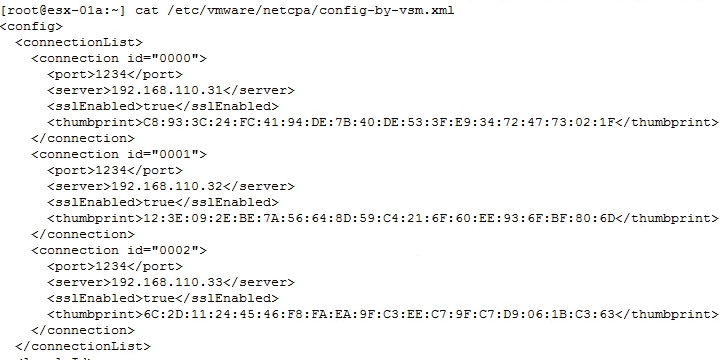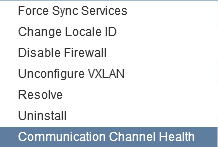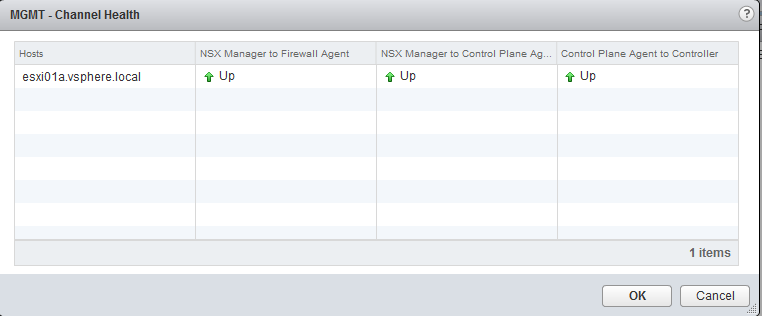In this section we perform manual verification that the VIBs have been successfully installed.
- SSH onto an ESXi host.
- Check whether VXLAN VIB modules have been installed by executing the following command:
esxcli software vib get --vibname esx-vxlan
- You will receive an output similar to the following:
[root@vSphere:~] esxcli software vib get --vibname esx-vxlan
VMware_bootbank_esx-vxlan_6.0.0-0.0.4987429
Name: esx-vxlan
Version: 6.0.0-0.0.4987429
Type: bootbank
Vendor: VMware
Acceptance Level: VMwareCertified
Summary: Vxlan and host tool
Description: This package loads module and configures firewall for vxlan networking.
ReferenceURLs:
Creation Date: 2017-01-27
Depends: esx-base >= 6.0, esx-base <= 6.5.0, nsx-api <= 2.1, vmkapi_2_3_0_0
Conflicts: nsx-api = 2
Replaces: esx-traceflow, esx-dvfilter-switch-security, esx-bfd
Provides: com.vmware.vxlan = 1.0.0.0-nsx, com.vmware.switchsecurity = 1.0.0.0, com.vmware.traceflow = 1.0.0.0, com.vmware.bfd = 1.0.0.0
Maintenance Mode Required: True
Hardware Platforms Required:
Live Install Allowed: True
Live Remove Allowed: True
Stateless Ready: True
Overlay: False
Tags:
Payloads: esx-vxlan
- If the module has been installed correctly, you should see open TCP connections on port 1234 with the following command:
esxcli network ip connection list | grep 1234
An example is included below that shows the connection as established to each of the three NSX controllers from the point of view of an ESXi host:
- To see which NSX controllers the host is configured to communicate with, execute the following command:
cat /etc/vmware/netcpa/config-by-vsm.xml
The following screenshot provides a truncated output of the command and its expected output.
- Check if VSIP VIB modules have been installed by executing the following command: esxcli software vib get --vibname esx-vsip:
- You will receive an output similar to the following:
[root@vSphere:~] esxcli software vib get --vibname esx-vsip
VMware_bootbank_esx-vsip_6.0.0-0.0.4987429
Name: esx-vsip
Version: 6.0.0-0.0.4987429
Type: bootbank
Vendor: VMware
Acceptance Level: VMwareCertified
Summary: vsip module
Description: This package contains DFW and NetX data and control plane components.
ReferenceURLs:
Creation Date: 2017-01-27
Depends: esx-base >= 6.0, esx-base <= 6.5.0, nsx-api <= 2.1, vmkapi_2_3_0_0
Conflicts: nsx-api = 2
Replaces: esx-vdpi
Provides: vsip = 1.0.0-0
Maintenance Mode Required: True
Hardware Platforms Required:
Live Install Allowed: True
Live Remove Allowed: True
Stateless Ready: True
Overlay: False
Tags:
Payloads: esx-vsip
- If the module has been installed correctly, you can open TCP connections on port 5671 with the following command:
esxcli network ip connection list | grep 5671
The following screenshot provides an example of the above command, the output shows a connection of established to the NSX Manager over TCP Port 5671:
- To see which NSX Manager the host is configured to communicate with, execute the following command:
esxcfg-advcfg -g /UserVars/RmqIpAddress
The following screenshot shows the results of the execution of the command above, and the expected configuration parameter is the IP address of the NSX Manager:



 Free Chapter
Free Chapter






